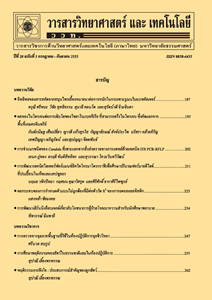การจำแนกพื้นที่ป่าผลัดใบโดยใช้ภาพดาวเทียมแลนด์แซทหลายช่วงเวลากับเทคนิคอัตราส่วนช่วงคลื่น
Main Article Content
Abstract
The objective of the study is to evaluate optimum dataset of multitemporal band ratio of Landsat 8 for forest type classification in deciduous forest area surrounding of Queen Sirikit Dam using supervised classification with maximum likelihood classifier (MLC). In this study, imageries data acquiring during January 2014 to November 2015 were used to create the monthly band ratio data of normalized difference vegetation indices (NDVI), normalized difference moisture indices (NDMI) and normalized burn ratios (NBR) and then used also to create the single-date multispectral data (only 27th January 2015). Then, 4 datasets were used for forest type classification into 2 classes that were mixed dipterocarp and dry dipterocarp forest. After accuracy assessment, the result showed that overall accuracy and kappa coefficient of all datasets with MLC were between 62.75-77.50 % and between 25.00-55.00 %, respectively. Herein, NDVI multitemporal data provided the highest overall accuracy and kappa coefficient, these values were better than single-date multispectral data about 4.00 and 8.00 %, respectively. In conclusion, applying multitemporal data of Landsat 8 with band ratio technique, especially NDVI, can increase the accuracy of forest type classification.
Keywords: multitemporal Landsat 8 data; band ratio technique; forest type classification; deciduous forest
Article Details
References
[2] พบพร รัตนสุวรรณ, 2556, การศึกษาการเปลี่ยนแปลงสภาพพื้นที่ต้นน้ำลำธารในลุ่มน้ำเพชรบุรี, รายงานการวิจัย, กรมอุทยานแห่งชาติ สัตว์ป่าและพันธุ์พืช, กรุงเทพฯ, 51 น.
[3] ณิชนันทน์ บุญญาทรัพย์ และกาญจน์เขจร ชูชีพ, 2554, การประยุกต์การสำรวจระยะไกลและระบบสารสนเทศภูมิศาสตร์เพื่อวิเคราะห์หาแนวเชื่อมต่อป่าและแนวทางการจัดการป่าไม้ในพื้นที่กลุ่มป่าตะวันออก, ว.การจัดการป่าไม้ 5(10): 78-79.
[4] สำนักจัดการที่ดินป่าไม้, 2559, โครงการจัดทำข้อมูลสภาพพื้นที่ป่าไม้, รายงาน, กรมป่าไม้, กรุงเทพฯ, 158 น.
[5] ดวงรัตน์ คล้ายเดช, 2556, การใช้ดัชนีพืชพรรณจากข้อมูลดาวเทียมไทยโชตสำหรับการจำแนกชนิดป่าในอุทยานแห่งชาติดอยหลวง จังหวัดเชียงราย, วิทยานิพนธ์ปริญญาโท, มหาวิทยาลัย เกษตรศาสตร์, กรุงเทพฯ, 104 น.
[6] Jensen, J.R., 2005, Introductory Digital Image Processing: A Remote Sensing Perspective, 2nd Ed., Prentice Hall, New Jersey, 526 p.
[7] เปรมศิริ คงเส้ง, 2560, การจำแนกการใช้ประโยชน์ที่ดินและสิ่งปกคลุมดินของจังหวัดภูเก็ตจากภาพถ่ายดาวเทียมแลนด์แซท 8 ด้วยคุณสมบัติทางชีพลักษณ์, วิทยานิพนธ์ปริญญาโท, มหาวิทยาลัยสงขลานครินทร์, สงขลา, 69 น.
[8] Oliveira, T. C. de A., 2009, Remote Sensing of Deciduous Forests: A Multi Temporal Approach, Ph.D. Thesis, Universidade Federal de Lavras, Brasil, 43 p.
[9] Patakamuria S. K., Agrawalb S. and Krishnavenia M., 2014, Time-series analysis of MODIS NDVI data along with ancillary data for land use/land cover mapping of Uttarakhand, The Internatio-nal Archives of the Photogrammetry, Remote Sensing and Spatial Information Sciences, Volume XL-8, 2014 ISPRS Technical Commission VIII Symposium: 1491-1500.
[10] Simonetti E., Simometti D. and Preatoni D., 2014, Phenology-based Land Cover Classification using Landsat 8 Time Series, Technical Report, Joint Research Centre of the European Commission, 57 p.
[11] สำนักอนุรักษ์สัตว์ป่า, 2560, ลำน้ำน่าน, แหล่งที่มา : http://park.dnp.go.th/visitor/nation parkshow.php?pta_code=1086, 5 ธันวาคม 2560.
[12] U.S. Geological Survey, 2017, Band Designations for Landsat Satellites, Available Source: https://landsat.usgs.gov /what-are-band-designations-landsat-satellites, August 19, 2017.
[13] U.S. Geological Survey, 2017, Landsat Spectral Indices Product Guide, Available Source: https://landsat.usgs.gov/sites/def ault/files/documents/si_product_guide.pdf, August 19, 2017.
[14] Fitzpatrick-Lins K., 1981, Comparison of sampling procedures and data analysis for a land-use and land-cover map, Photogramm. Eng. Remote Sens. 47: 343-351.
[15] สุวิทย์ อ๋องสมหวัง, 2559, ระบบการรับรู้ระยะไกลและการวิเคราะห์ข้อมูลภาพเชิงเลข, เอกสารประกอบการสอน, สาขาวิชาการรับรู้จากระยะไกล สำนักวิชาวิทยาศาสตร์ มหาวิทยาลัยเทคโนโลยีสุรนารี, นครราชสีมา, 1009 น.
[16] Story, M. and Congalton, R., 1986, Accuracy assessment: A user’s perspective, Photogramm. Eng. Remote Sens. 52: 397-399.
[17] Ongsomwang, S. and Saraisamrong, S., 2017, Pixel-based and object-based image analysis comparison for land use and land cover classification, J. Remote Sens. GIS Assoc. Thai. 18(2-3): 1-22.
[18] Wilson, E.H. and Sader, S.A., 2002, Detection of forest harvest type using multiple dates of landsat TM imagery, Remote Sens. Environ. 80: 385-396.


